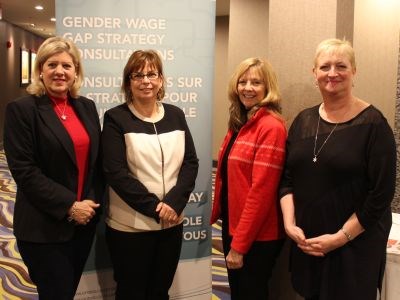Marianne Matichuk remembers picketing at her high school in the 1970s, protesting the exclusion of girls from shop class. The campaign was successful, and she and her peers gained access to skills training previously reserved for their male classmates.
In many ways, that's where the progress stopped, said Matichuk. While she saw movements for workplace equality in the 1980s and 1990s, she said she has not yet seen the changes she'd like in education, hiring practices and wage equity for women in the workforce.
Matichuk represented the Sudbury chapter of Business & Professional Women at a December town hall meeting held by the Gender Wage Gap Strategy Steering Committee, formed by the Ministry of Labour. The committee stopped in Sudbury as part of its consultation process, which is covering 14 Ontario communities.
According to the consultation document, “the Ontario government is examining ways that government, business, labour, and individuals can work together to identify opportunities — and barriers — to closing the gender wage gap.”
The wage gap in Ontario, on average, ranges from 12 to 31 per cent. The presentation by the committee pointed out that Aboriginal women who have immigrated and women living with a disability often face a wider gap, and that the gap also varies across communities and industries.
“We know there's a difference between different parts of the province,” said Nancy Austin, executive lead on the committee.
The Sudbury participants represented a cross-section of the workforce, with representatives from women's professional organizations, women's advocacy groups, and a significant turnout by members of the mining community.
One attendee who has worked for decades in mining discussed the difficulties she faces as a women seeking work after the recent closure of the nickel company she worked for.
“I'm well qualified, but the same issues are always there, it's a struggle to get hired,” she said. “Of the people laid off, if one of the people is a woman and six of them are guys, the guys are going to get jobs first.”
Another participant who is the parent of two young girls said she faced discrimination in the public sector. She recounted being asked in a job interview what child care she had planned, and being challenged on using her sick days to care for her child. She left during her second pregnancy. Her current position in a non-profit role pays less, but more easily accommodates her pregnancy and parental needs in ways her other job did not.
Emanuela Heyninck, Ontario's Pay Equity Commissioner, moderated the discussion, and asked for specific ideas to remedy situations like those facing the women who spoke up.
Participants voiced their desire for stronger legislation that encourages women to gain education and employment in male-dominated industries and positions, and that holds employers accountable.
“The problem is, there's no accountability from employers to have a certain mix in the workplace,” said Matichuk, who recommended a system in which businesses are required to publicly report on how many women they employee, in a system like the public release of salaries in the form of a “sunshine list.”
Nicole Beaulieu is the executive director at the Sudbury Workers Education and Advocacy Centre. She suggested the implementation of specific legislation to accommodate women forming families. Specifically, she said she'd like to see schedule regulation to facilitate planning ahead, $15-per-day day care, and guaranteed paid sick days.
Beaulieu and other attendees also said they would like to see a reform of the Ontario educational system, highlighting the lack of change since Matichuk's experiences in the 1970s.
“I think it starts right at the beginning,” said Beaulieu. “The curriculum in schools is a real problem.”
She and other attendees opined that schooling should be less segregated by gender, and recommended that both life skills and trade programs be made mandatory.
“The need to de-gender who does what is clear,” responded Heyninck, and added that these recommendations were largely echoes of what they'd heard at consultations across Ontario. Feedback was recorded, and will be added to the committee's official report.
The committee will report back to government in early 2016 with the results of its consultations and with recommendations that will help shape the province's Gender Wage Gap Strategy.
The committee is accepting consultation submissions via mail until Jan. 15, 2016. Public consultations will continue through February. The information is available at www.labour.gov.on.ca/english/about/gwg/consultation.php.



